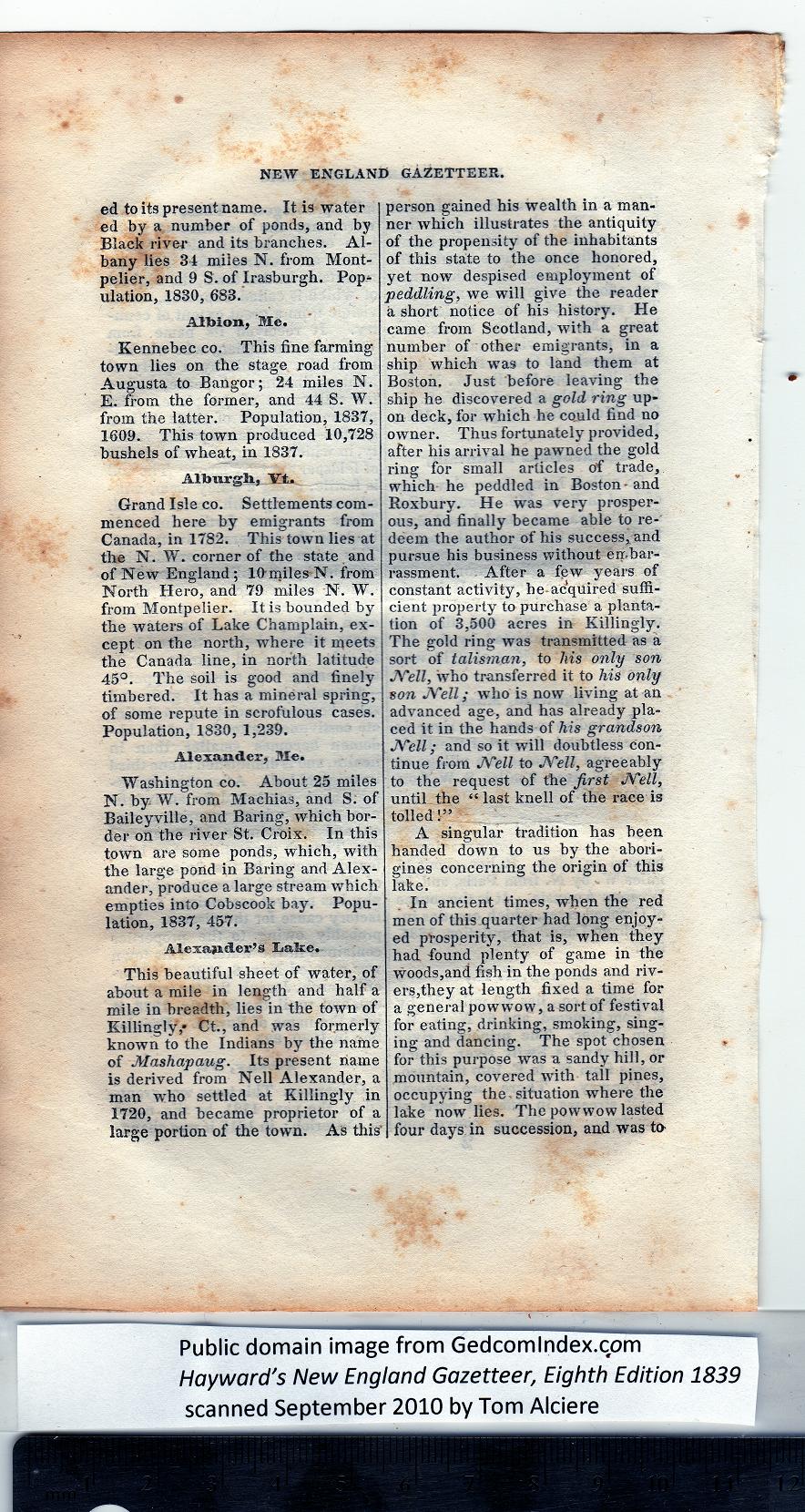|
ed to its present name. It is water
ed by a number of ponds, and by
Black river and its branches. Al-
bany lies 34 miles N. from Mont-
pelier, and 9 S. of Irasburgh. Pop-
ulation, 1830, 683.
Albion, Me.
Kennebec co. This fine farming
town lies on the stage road from
Augusta to Bangor; 24 miles N.
E. from the former, and 44 S. W.
from the latter. Population, 1837,
1609. This town produced 10,728
bushels of wheat, in 1837.
Alburgh, Vt.
Grand Isle co. Settlements com-
menced here by emigrants from
Canada, in 1782. This town lies at
the N. W. corner of the state and
of New England; 10’miles N. from
North Hero, and 79 miles N. W.
from Montpelier. It is bounded by
tbe waters of Lake Champlain, ex-
cept on the north, where it meets
the Canada line, in north latitude
45°. The soil is good and finely
timbered. It has a mineral spring,
of some repute in scrofulous cases.
Population, 1830, 1,239.
Alexander, Me.
Washington co. About 25 miles
N. by. W. from Machias, and S. of
Baileyville, and Baring, which bor-
der on the river St. Croix. In this
town are some ponds, which, with
the large pond in Baring and Alex-
ander, produce a large stream which
empties into Cobscook bay. Popu-
lation, 1837, 457.
Alexander’s Lake. |
This beautiful sheet of water, of
about a mile in length and half a
mile in breadth, lies in the town of
Killingly,* Ct., and was formerly
known to the Indians by the name
of Mashapaug. Its present name
is derived from Nell Alexander, a
man who settled at Killingly in
1720, and became proprietor of a
large portion of the town. As this’
person gained his wealth in a man-
ner which illustrates the antiquity
of the propensity of the inhabitants
of this state to the once honored,
yet now despised employment of
peddling, we will give the reader
a short notice of his history. He
came from Scotland, with a great
number of other emigrants, in a
ship which was to land them at
Boston. Just before leaving the
ship he discovered a gold ring up-
on deck, for which he could find no
owner. Thus fortunately provided,
after his arrival he pawned the gold
ring for small articles of trade,
which he peddled in Boston - and
Roxbury. He was very prosper-
ous, and finally became able to re-
deem the author of his success, and
pursue his business without embar-
rassment. After a few years of
constant activity, he-acquired suffi-
cient property to purchase a planta-
tion of 3,500 acres in Killingly.
The gold ring was transmitted as a
sort of talisman, to his only son
Nell, who transferred it to his only
son Nell; who is now living at an
advanced age, and has already pla-
ced it in the hands of his grandson
Nell; and so it will doubtless con-
tinue from Nell to Nell, agreeably
to the request of the first Nell,
until the “ last knell of the race is
tolled!”
A singular tradition has heen
handed down to us by the abori-
gines concerning the origin of this
lake.
In ancient times, when the red
men of this quarter had long enjoy-
ed prosperity, that is, when they
had found plenty of game in the
woods,and fish in the ponds and riv-
ers,they at length fixed a time for
a general powwow, a sort of festival
for eating, drinking, smoking, sing-
ing and dancing. The spot chosen
for this purpose was a sandy hill, or
mountain, covered with tall pines,
occupying the. situation where the
lake now lies. The powwow lasted
four days in succession, and was to- |
